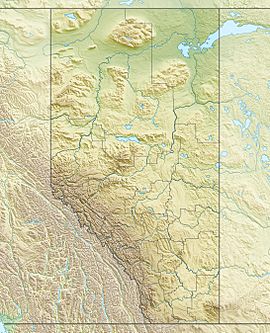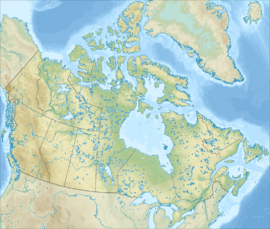Evelyn Peak facts for kids
Quick facts for kids Evelyn Peak |
|
|---|---|

Evelyn Peak seen from Bald Hills
|
|
| Highest point | |
| Elevation | 2,855 m (9,367 ft) |
| Prominence | 435 m (1,427 ft) |
| Parent peak | Mount Kerkeslin (2950 m) |
| Listing | Mountains of Alberta |
| Geography | |
| Location | Jasper National Park Alberta, Canada |
| Parent range | Maligne Range Canadian Rockies |
| Topo map | NTS 83C/12 |
| Geology | |
| Age of rock | Cambrian |
| Type of rock | Sedimentary rock |
| Climbing | |
| Easiest route | Scrambling |
Evelyn Peak is a mountain in Jasper National Park, Alberta, Canada. It stands tall at 2,855 m (9,367 ft) (about 9,367 feet). This peak is part of the Canadian Rockies and sits in the beautiful Athabasca River valley.
Evelyn Peak is close to other important mountains. Mount Kerkeslin is about 5.0 km (3.1 mi) to the southwest. Mount Hardisty is about 6.0 km (3.7 mi) to the northwest. All these peaks belong to the Maligne Range.
The mountain is made of sedimentary rock. This type of rock formed from layers of sand and mud over millions of years. These layers were laid down during the Cambrian period, a very long time ago. Later, powerful forces pushed these rocks upwards. This happened during an event called the Laramide orogeny, which helped create the Rocky Mountains.
Evelyn Peak is where Evelyn Creek begins. The mountain is also three kilometers south of Evelyn Pass. Both the creek and the pass were named in 1921. They honor Evelyn Cavendish, Duchess of Devonshire (1870–1960). She visited the nearby Maligne Lake in 1920. However, the mountain's name has not yet been officially recognized by the Geographical Names Board of Canada.
Understanding the Climate of Evelyn Peak
Evelyn Peak is located in a subarctic climate zone. This means the area has very cold and snowy winters. Summers are usually mild, not too hot.
Temperatures and Weather
During winter, temperatures can drop below -20 °C (which is -4 °F). With the wind chill, it can feel even colder, sometimes below -30 °C (-22 °F). This makes the mountain a very chilly place in winter.
Water Flow from the Peak
Any rain or melting snow from Evelyn Peak flows into Evelyn Creek. From there, the water eventually drains into the large Athabasca River. This river is an important waterway in Alberta.



